If you love seafood, you might have tried salmon fillets, steaks, or sushi. But have you ever heard of salmon kama? It’s a part of the fish that’s often overlooked but is incredibly flavorful and tender.
Picture biting into crispy, golden skin with soft, fatty meat beneath. It’s a truly delightful experience! Yet, many people don’t know about it because it’s not often found on menus.
In this guide, we’ll dive into what makes salmon kama special. We’ll also cover how to prepare it, the best cooking methods, and why you should try it for dinner tonight.
Table of Contents
What is Salmon Kama?
A Hidden Gem of the Fish World
Salmon kama refers to the collar of the salmon, the area right behind the gills and below the head. It’s a small, meaty, and incredibly tender part that is often overlooked or discarded.
But why? Because most people go straight for the fillets, leaving this delicacy to those in the know. In Japan, however, kama (which means “collar” in Japanese) is prized for its fatty richness and buttery texture.
“Salmon kama is like the filet mignon of the fish world—soft, juicy, and full of flavor.”
Why is Salmon Kama So Flavorful?
The collar of the fish is where some of the highest fat content is stored. This fat renders beautifully when cooked, resulting in a moist, rich, and deeply flavorful bite.
Unlike salmon fillets, which can dry out easily, salmon kama stays juicy and tender, even with high-heat cooking methods like grilling or broiling.
Understanding Salmon Kama
What Part of the Fish is Kama?
The kama is the meaty section found near the fish’s pectoral fins, just behind the head. Since this area is not heavily used for movement, the muscle fibers remain delicate and tender.
If you’ve ever had Hamachi Kama (yellowtail collar) at a sushi restaurant, salmon kama is its close cousin, offering a similar buttery taste but with a more robust salmon flavor.
Is Salmon Kama Healthy? Nutritional Benefits
Salmon is already known as a superfood, and salmon kama is no exception. This cut is packed with healthy omega-3 fatty acids, which are great for brain health, heart function, and reducing inflammation.
Here’s a nutritional breakdown per 100g of salmon kama:
| Nutrient | Amount |
|---|---|
| Calories | 210 kcal |
| Protein | 22g |
| Omega-3 Fatty Acids | 2.5g |
| Total Fat | 14g |
| Vitamin D | 90% DV |
| Calcium | 15% DV |
Why eat salmon kama?
- Rich in Omega-3s – Supports heart and brain health
- High-Quality Protein – Helps build muscle and keep you full
- Vitamin D Boost – Strengthens bones and immune system
- Low in Carbs – Perfect for keto and low-carb diets
“If you’re looking for a delicious way to boost your omega-3 intake, salmon kama is a fantastic choice.”
How to Choose and Buy Salmon Kama
Where to Find Salmon Kama?
Salmon kama isn’t as commonly sold as fillets, but you can still find it in:
- Japanese grocery stores (Look in the seafood section)
- Asian markets (Fresh or frozen options available)
- Fish markets (Ask the fishmonger if they have salmon collars)
- Online seafood suppliers (Many specialty shops sell fresh salmon kama)
Some stores throw away salmon collars because they don’t know how valuable they are. If you don’t see them displayed, just ask the fishmonger—they might have some in the back! And if you’re wondering whether seasoning affects fish before cooking, check out this guide on should you season fish before deep frying for expert insights.
How to Select the Best Quality Salmon Kama
When choosing fresh salmon kama, look for:
✔ Bright, glossy skin – No dullness or dryness
✔ Firm flesh – Should spring back when pressed
✔ Mild, fresh scent – Avoid fishy or ammonia-like odors
✔ Rich, deep color – Pink to orange, depending on the salmon species
Pro Tip: If buying frozen salmon kama, make sure there’s no excessive ice buildup (a sign of freezer burn).
How to Prepare Salmon Kama for Cooking
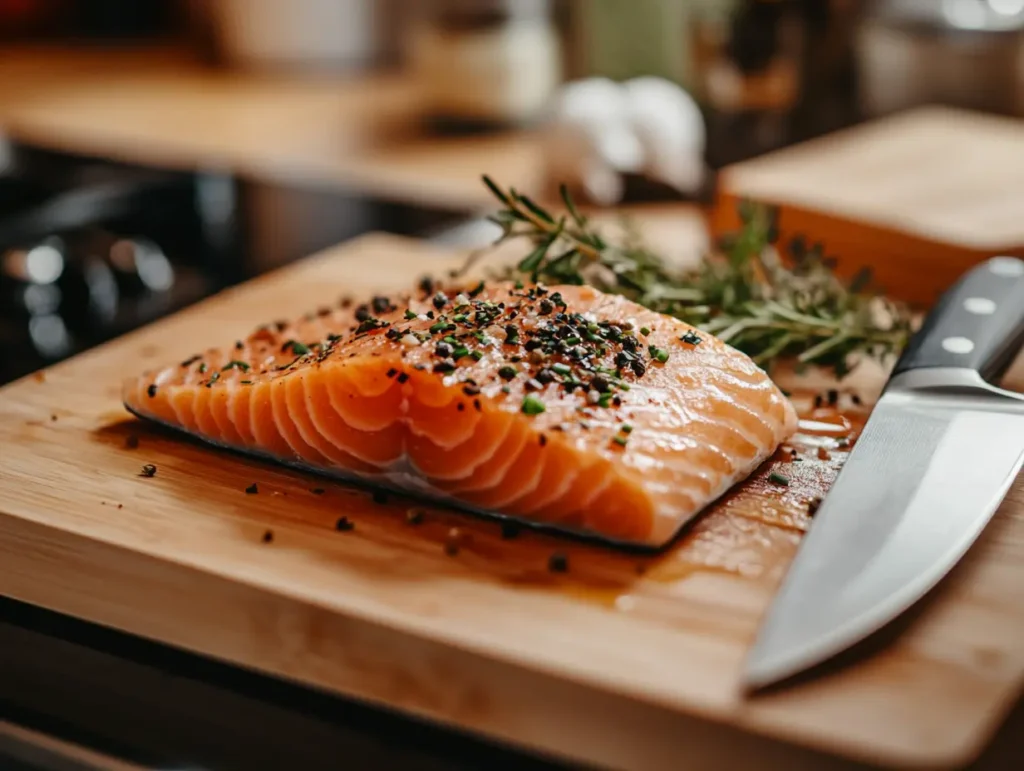
Cleaning and Prepping Salmon Kama
Preparing salmon kama is super easy! Here’s what you need to do:
- Rinse under cold water – This removes any remaining scales or blood.
- Pat dry with paper towels – Moisture prevents crispy skin.
- Trim excess fins (optional) – If your salmon kama still has fins attached, use kitchen shears to remove them.
That’s it! Your salmon kama is now ready for seasoning.
Marination Tips for Maximum Flavor
While salmon kama is naturally delicious, a simple marinade can take it to the next level. For more seasoning ideas, check out this guide on the best seasoning for fish to bring out even more incredible flavors! Here’s a basic Japanese-style marinade:
Ingredients:
| Ingredient | Quantity |
|---|---|
| Soy Sauce | ¼ cup |
| Mirin (Sweet Rice Wine) | 2 tbsp |
| Sake | 2 tbsp |
| Garlic (minced) | 2 cloves |
| Ginger (grated) | 1 tsp |
| Honey or Sugar | 1 tsp |
Steps:
- Mix all ingredients in a bowl.
- Place salmon kama in a zip-top bag or shallow dish.
- Pour the marinade over the fish.
- Let it marinate for 30 minutes to 2 hours (the longer, the better).
- Remove from marinade and pat dry slightly before cooking to get a nice sear.
“A quick marinade enhances flavor without overpowering the natural richness of salmon kama.”
The Best Ways to Cook Salmon Kama
Now that you know what salmon kama is, its nutritional benefits, and how to prepare it, it’s time for the best part—cooking! If you love seafood, you might also enjoy this fishcakes and scallops stir-fry recipe for another delicious dinner idea.
Salmon kama is versatile and can be cooked in various ways. The most popular and effective methods include:
- Grilling – Brings out smoky flavors and crisps up the skin.
- Broiling – Achieves a perfect charred crust while keeping the inside juicy.
- Pan-searing – Quick and easy, creating crispy skin with minimal effort.
- Baking or Roasting – Great for a hands-off approach.
Let’s dive into these step-by-step recipes so you can make restaurant-quality salmon kama at home!
Grilled Salmon Kama Recipe (Step-by-Step)
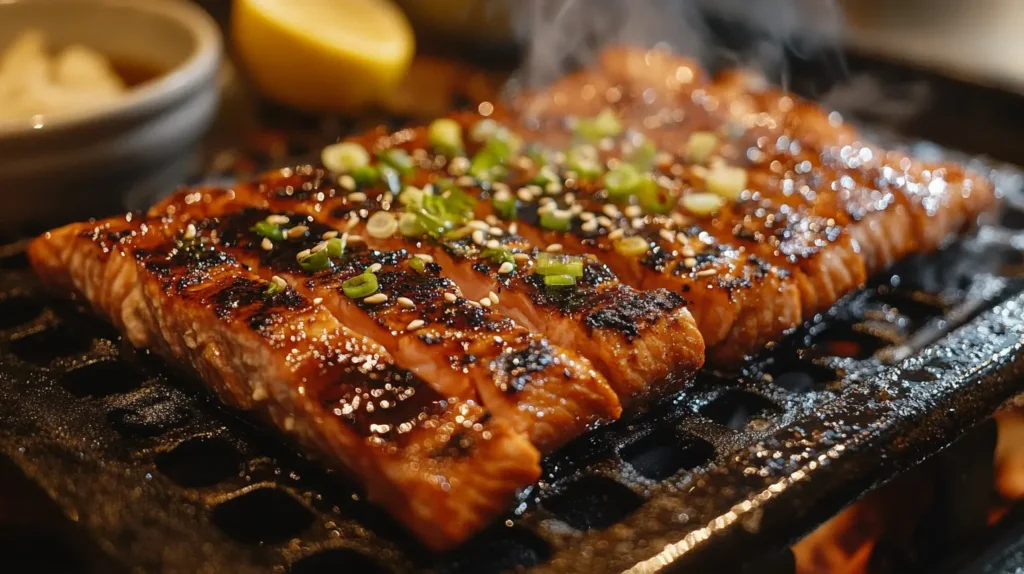
Why Grill Salmon Kama?
Grilling enhances the natural umami of salmon kama while creating crispy skin and smoky depth. It’s also one of the easiest ways to cook it, requiring minimal ingredients.
Ingredients:
| Ingredient | Quantity |
|---|---|
| Salmon Kama | 2 pieces |
| Soy Sauce | 2 tbsp |
| Lemon Juice | 1 tbsp |
| Olive Oil | 1 tbsp |
| Garlic (minced) | 1 clove |
| Salt & Pepper | To taste |
Instructions:
- Preheat the grill to medium-high heat (around 400°F).
- Pat the salmon kama dry with a paper towel.
- Mix soy sauce, lemon juice, olive oil, and garlic in a small bowl.
- Brush the mixture onto the salmon kama, coating evenly.
- Place the salmon kama skin-side down on the grill grates.
- Grill for 5-6 minutes per side, or until the skin is crispy and the inside is tender.
- Remove from grill and let it rest for a minute before serving.
- Serve with extra lemon wedges and enjoy!
Pro Tips for Perfect Grilled Salmon Kama:
✅ Use a clean, well-oiled grill to prevent sticking.
✅ Don’t flip too early—let the skin crisp up first.
✅ Baste with extra marinade during grilling for added flavor.
“Grilled salmon kama is a must-try if you love smoky flavors and crispy textures!”
Broiled Salmon Kama Recipe (Step-by-Step)
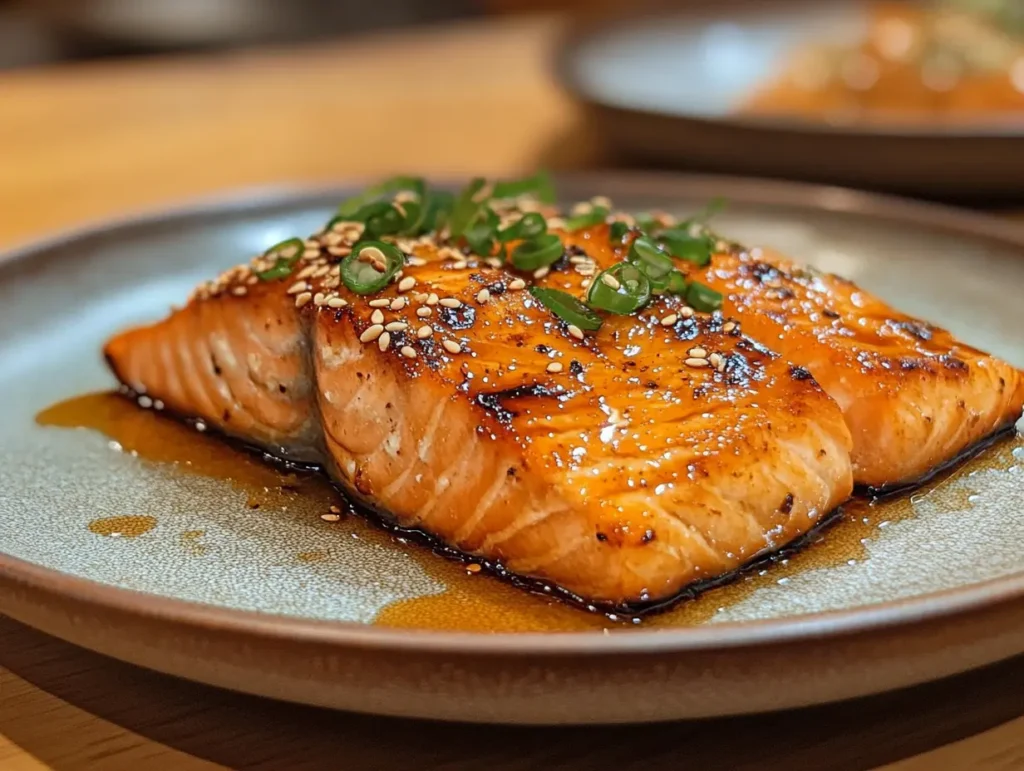
Why Broil Salmon Kama?
Broiling gives the perfect balance of crispy outside and tender inside—without needing a grill! It’s an indoor-friendly method that works year-round.
Ingredients:
| Ingredient | Quantity |
|---|---|
| Salmon Kama | 2 pieces |
| Miso Paste | 1 tbsp |
| Mirin | 2 tbsp |
| Sake | 2 tbsp |
| Brown Sugar | 1 tsp |
Instructions:
- Preheat the oven broiler to high.
- Mix miso paste, mirin, sake, and brown sugar in a bowl.
- Brush the marinade generously over the salmon kama.
- Line a baking sheet with foil and place the salmon kama on it.
- Broil for 6-7 minutes per side, or until the top is golden brown and slightly charred.
- Let it rest for 2 minutes before serving.
Pro Tips for Broiling Salmon Kama:
✅ Keep a close eye while broiling—it can burn quickly!
✅ Use foil-lined trays for easy cleanup.
✅ Flip only once for even cooking.
“Broiling caramelizes the miso marinade, adding a deep, umami-packed flavor to the dish.”
Pan-Seared Salmon Kama
Why Pan-Sear Salmon Kama?
Pan-searing is quick and effective, especially if you don’t have access to a grill or broiler. It produces crispy skin and a moist, flaky interior in minutes!
Ingredients:
| Ingredient | Quantity |
|---|---|
| Salmon Kama | 2 pieces |
| Butter | 1 tbsp |
| Olive Oil | 1 tbsp |
| Garlic (minced) | 1 clove |
| Salt & Pepper | To taste |
Instructions:
- Heat olive oil and butter in a pan over medium-high heat.
- Pat the salmon kama dry and season with salt and pepper.
- Place the salmon kama skin-side down in the hot pan.
- Cook for 4-5 minutes until the skin is crispy.
- Flip and cook for another 3-4 minutes on the other side.
- Add garlic in the last minute and baste with the butter.
- Remove from heat and serve immediately.
Pro Tips for Pan-Searing:
✅ Use high heat for the crispiest skin.
✅ Don’t move the fish too much—let it sear properly.
✅ Baste with butter and garlic for added richness.
“Pan-searing is the fastest way to get crispy, golden skin with minimal effort!”
Common Problems & Solutions When Cooking Salmon Kama
Even though salmon kama is easy to cook, some common issues can arise. Here’s how to avoid mistakes and perfect your dish!
Why Does Salmon Kama Stick to the Grill?
- Problem: The skin sticks and rips when flipping.
- Solution: Ensure the grill grates are clean and oiled before cooking. Let the fish cook undisturbed for a few minutes before flipping.
How to Prevent Overcooking?
- Problem: The salmon kama turns out dry.
- Solution: Cook only until the flesh is opaque and flakes easily. Use a thermometer (125°F for medium).
How to Enhance the Umami Flavor?
- Problem: The fish tastes bland.
- Solution: Marinate it for at least 30 minutes with soy sauce, miso, or citrus-based seasonings for depth of flavor.
“With the right techniques, cooking salmon kama is easy and foolproof!”
Best Side Dishes to Serve with Salmon Kama
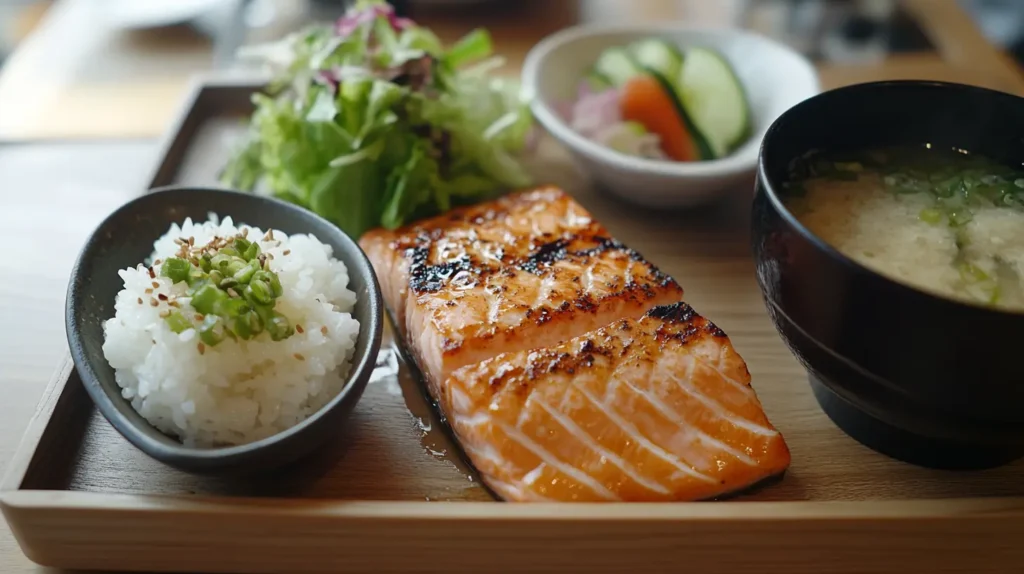
Salmon kama is rich, flavorful, and packed with umami, making it a fantastic centerpiece for dinner. But what should you serve with it? Choosing the right side dishes can balance out its richness and elevate the meal.
Traditional Japanese Accompaniments
If you want an authentic Japanese experience, try pairing salmon kama with these classic side dishes:
1. Steamed White Rice (Gohan)
A simple bowl of steamed Japanese short-grain rice is a perfect match for salmon kama. The neutral flavor of rice helps balance the richness of the fish while soaking up any leftover juices. Want to elevate your rice? Try this rice hack recipe for a flavorful twist!
“A bite of salmon kama followed by a spoonful of fluffy rice is pure comfort food!”
2. Miso Soup
Miso soup adds a warm, savory element to the meal. It’s light, flavorful, and complements the umami-packed salmon kama beautifully.
Basic Miso Soup Ingredients:
| Ingredient | Quantity |
|---|---|
| Dashi (Japanese Broth) | 2 cups |
| Miso Paste | 1 tbsp |
| Tofu (cubed) | ½ cup |
| Wakame (Seaweed) | 1 tbsp |
| Green Onions | 1 tbsp |
Modern Side Dish Pairings
If you prefer a fusion-style meal, here are some modern pairings that work beautifully with salmon kama.
3. Roasted Vegetables
Roasting brings out the natural sweetness in vegetables, creating a perfect contrast to the savory richness of salmon kama. Try asparagus, zucchini, carrots, or bell peppers.
Quick Roasted Veggies Recipe:
- Preheat oven to 400°F (200°C).
- Toss chopped vegetables with olive oil, salt, pepper, and garlic.
- Roast for 15-20 minutes until tender and slightly caramelized.
4. Asian Cucumber Salad
A refreshing cucumber salad cuts through the richness of the fish and adds a touch of acidity.
Quick Cucumber Salad Dressing:
- 1 tbsp rice vinegar
- ½ tbsp soy sauce
- ½ tsp sesame oil
- ½ tsp sugar
- Sprinkle of sesame seeds
“Pairing salmon kama with fresh, crisp sides creates a well-balanced meal!”
Storing and Reheating Salmon Kama
Cooked salmon kama can be stored and reheated while maintaining its crispy texture and juicy interior—if done correctly!
How to Store Leftover Salmon Kama
In the Refrigerator:
- Let the salmon kama cool completely before storing.
- Wrap it tightly in foil or plastic wrap to prevent drying out.
- Store in an airtight container and refrigerate for up to 3 days.
In the Freezer:
- Wrap each piece in plastic wrap and then place in a zip-top bag.
- Label with the date and freeze for up to 2 months.
“For best flavor, eat refrigerated salmon kama within 3 days and frozen salmon kama within 2 months.”
Best Ways to Reheat Salmon Kama
Reheating salmon kama improperly can dry it out or make it rubbery. Here’s how to reheat it the right way:
1. Reheating in the Oven (Best Method)
- Preheat oven to 300°F (150°C).
- Place salmon kama on a baking sheet.
- Cover loosely with foil to prevent moisture loss.
- Heat for 10-12 minutes or until warmed through.
2. Reheating on the Stovetop
- Heat a nonstick pan over medium-low heat.
- Add a few drops of olive oil.
- Reheat for 3-4 minutes per side.
3. Reheating in the Air Fryer (For Crispiness)
- Set air fryer to 325°F (160°C).
- Heat for 5-6 minutes, flipping halfway.
“Avoid using the microwave—it makes salmon kama dry and rubbery!”
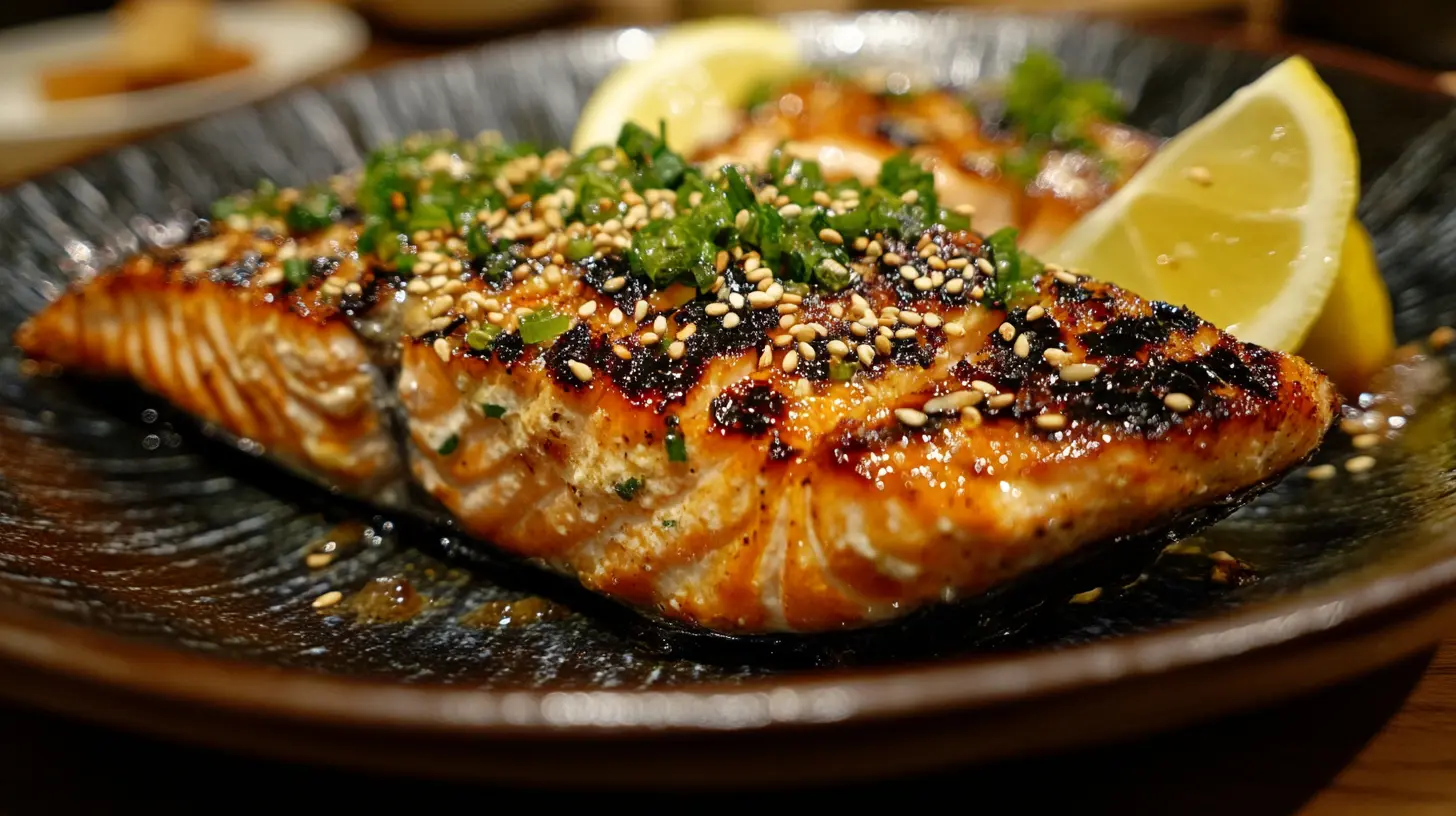
Salmon Kama
Ingredients
Equipment
Method
- Rinse the salmon kama under cold water to remove any remaining scales or blood. Pat dry with paper towels.
- Optional: Trim off any excess fins using kitchen shears.
- In a bowl, combine soy sauce, mirin, sake, garlic, ginger, and honey or sugar. Mix well.
- Place the salmon kama in a zip-top bag or shallow dish. Pour marinade over and refrigerate for 30 minutes to 2 hours.
- Preheat grill to medium-high heat (about 400°F). Pat the marinated kama slightly dry for better searing.
- Mix together soy sauce, lemon juice, olive oil, and garlic. Brush this mixture over the kama.
- Place the kama skin-side down on oiled grill grates. Grill for 5–6 minutes per side until skin is crispy and meat is opaque.
- Remove from grill and let rest for 1 minute. Serve hot with lemon wedges.
Notes
Frequently Asked Questions (FAQ)
What is Salmon Kama?
Salmon kama is the collar of the salmon, located right behind the gills. It is rich, fatty, and full of flavor, often considered the best part of the fish due to its tender, juicy texture.
What Part of the Fish is Kama?
“Kama” refers to the collar of the fish, the meaty section just below the head. This area is rarely used for movement, making it incredibly tender.
Are Salmon Collars Good?
Absolutely! Salmon collars (kama) are prized for their high-fat content, rich umami flavor, and soft, melt-in-your-mouth texture. They’re also nutrient-dense and considered a delicacy in Japanese cuisine.
Is Hamachi Kama Healthy?
Yes! Hamachi kama (yellowtail collar) and salmon kama are both rich in omega-3 fatty acids, protein, and essential vitamins. They’re a great low-carb, high-protein option for a healthy diet.
“Salmon kama is not only delicious but also packed with nutrients that benefit overall health!”
Conclusion
If you haven’t tried salmon kama, you’re missing out on one of the most delicious, underrated cuts of fish! It’s easy to prepare, incredibly flavorful, and perfect for grilling, broiling, or pan-searing.
Why You Should Try Cooking Salmon Kama Tonight:
✔ Rich, buttery texture that melts in your mouth.
✔ High in healthy omega-3s for brain and heart health.
✔ Budget-friendly and sustainable—a great way to use more of the fish!
✔ Easy to cook with minimal ingredients.
Pair it with steamed rice, miso soup, or fresh veggies for a well-rounded dinner. Whether you’re a seafood lover or just looking to try something new, salmon kama is a game-changer!
“Next time you visit a seafood market, ask for salmon kama—you won’t regret it!”
Final Thoughts
Now that we’ve covered everything about salmon kama, from what it is to how to cook, store, and serve it, you’re fully equipped to make this delicious dish at home.
If you loved this guide, don’t forget to share it with fellow seafood lovers and leave a comment with your favorite way to cook salmon kama!
